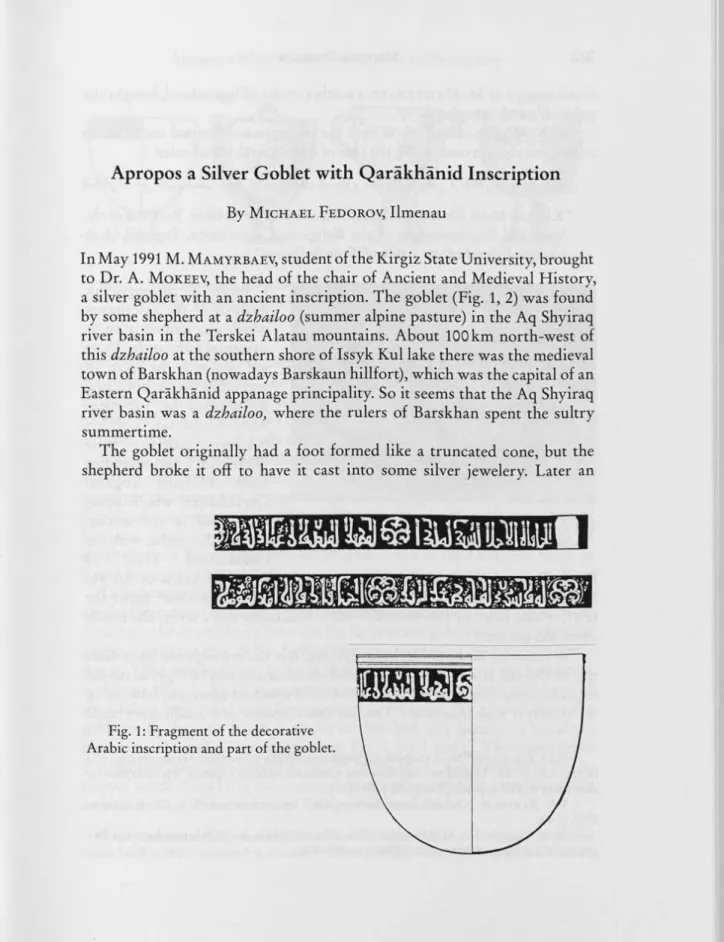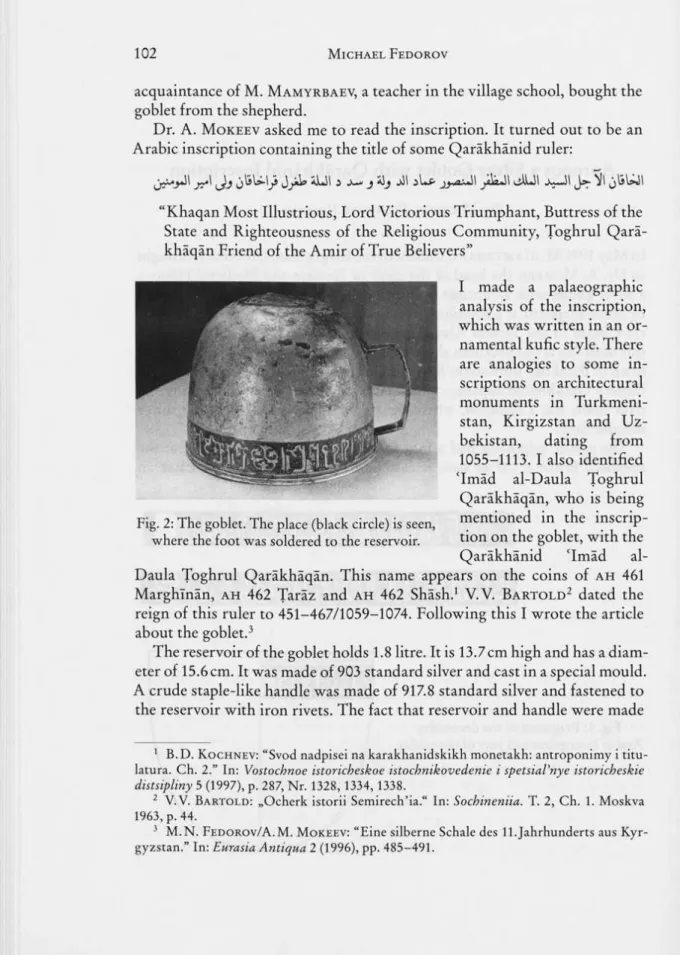By Michael Fedorov, Ilmenau
In May 1991 M. Mamyrbaev, student of the Kirgiz State University, brought
to Dr. A. MoKEEV, the head of the chair of Ancient and Medieval History,
a silver goblet with an ancient inscription. The goblet (Fig. 1, 2) was found
by some shepherd at a dzhailoo (summer alpine pasture) in the Aq Shyiraq
river basin in the Terskei Alatau mountains. About 100 km north-west of
this dzhailoo at the southern shore of Issyk Kul lake there was the medieval
town of Barskhan (nowadays Barskaun hillfort), which was the capital of an
Eastern Qaräkhänid appanage principality. So it seems that the Aq Shyiraq
river basin was a dzhailoo, where the rulers of Barskhan spent the sultry
summertime.
The goblet originally had a foot formed like a truncated cone, but the
shepherd broke it off to have it cast into some silver jewelery. Later an
imm I
Fig. 1: Fragment of the decorative Arabic inscription and part of the goblet.
102 Michael Fedorov
acquaintance of M. Mamyrbaev, a teacher in the village school, bought the
goblet from the shepherd.
Dr. A. MoKEEv asked me to read the inscription. It turned out to be an
Arabic inscription containing the title of some Qaräkhänid ruler:
yJ\ ^Jj jÜlä-lji JjiU iJJl J J iJj jJl iLp jy^ixS\ LiUJl Ja- ^ll jliUiJl
"Khaqan Most Illustrious, Lord Victorious Triumphant, Buttress of the
State and Righteousness of the Religious Community, Toghrul Qarä-
khäqän Friend of the Amir of True Believers"
I made a palaeographie
analysis of the inscription,
which was written in an or¬
namental kufic style. There
are analogies to some in¬
scriptions on architectural
monuments in Turkmeni¬
stan, Kirgizstan and Uz¬
bekistan, dating from
1055-1113. I also identified
Tmäd al-Daula Toghrul
Qaräkhäqän, who is being
Fig 2: The goblet. The place (black circle) is seen, mentioned in the inscrip-
where the foot was soldered to the reservoir. tion on the goblet, with the
Qaräkhänid Tmäd al-
Daula Toghrul Qaräkhäqän. This name appears on the coins of ah 461
Marghlnän, ah 462 Taräz and ah 462 Shäsh.' V.V. Bartold^ dated the
reign of this ruler to 451-467/1059-1074. Following this I wrote the article
about the goblet.'
The reservoir of the goblet holds 1.8 litre. It is 13.7cm high and has a diam¬
eter of 15.6 cm. It was made of 903 standard silver and cast in a special mould.
A crude staple-like handle was made of 917.8 standard silver and fastened to
the reservoir with iron rivets. The fact that reservoir and handle were made
' B.D. Kochnev; "Svod nadpisei na karakhanidskikh monetakh: antroponimy i titu- latura. Ch. 2." In: Vostochnoe istoricheskoe istochnikovedenie i spetsial'nye istoricheskie dtststpliny 5 (1997), p. 287, Nr. 1328, 1334, 1338.
2 V.V. Bartold: „Ocherk istorii Semirech'ia." In: Sochineniia. T. 2, Ch. 1. Moskva 1963, p. 44.
' M.N. Fedorov/A.M. Mokeev: "Eine silberne Schale des 1 I.Jahrhunderts aus Kyr- gyzstan." In: Eurasia Antiqua 2 (1996), pp. 485-491.
Fig. 3: 1: Reconstruction of the original form of the goblet (with the foot and without the handle); 2, 3, 4: Sarmatian bronze or copper cauldrons
of the 6'*' to 5* centuries bc
of different standard silver, indicates that the reservoir and the handle were
not made simultaneously. The handle was made at the same time as the in¬
scription, because there was an empty part left in the inscription where the
handle could be riveted to the reservoir. As a matter of fact this clumsy han¬
dle looks quite odd and spoils the exquisite appearance of the goblet.
When I was working on this article, my attention was drawn to the fact
that the goblet when it still had its foot resembled the goblet-shaped bronze
or copper cauldrons which were widespread among the ancient nomads who
populated vast steppe areas of South-Western Siberia, Kazakhstan, Central
Asia and South-Eastern Europe. Those nomads were called Scythians in
South-Eastern Europe, Sarmatians in areas south of the Ural, and Sacae in
Kazakhstan and Central Asia.
This thought had occurred to me often and I started to peruse the archae¬
ological literature on those ancient nomads and searched for analogies. Most
striking is the resemblance between the form of the goblet and the bronze or
copper cauldrons (Fig. 3, Nr. 2-4) of Sarmatian tribes of the 6''' to 5^^ centu¬
ries BC.* The similarity of the form of the goblet with one of the Sarmatian
cauldrons (Fig. 3, Nr. 2) is especially noteworthy. Of course, the form of
the goblet's foot could have been somewhat different, but when I drew the
goblet with the foot of the same form, that had this Sarmatian cauldron,
both vessels looked almost identical (cf. Fig. 3, Nr. 1 and 2). The main region
of origin of Sarmatians in the 6''' to 3'*' centuries bc was thought to be the
steppes south of the Ural, but archaeologists of Central Asia established that
some Sarmatian tribes were also living in Central Asia.
* K.F. Smirnov: "Savromatskaiia i rannesarmatskaiia kultury." In: Stepi evropeiskoi chastiSSSR v Skifo-Sarmatskoe vremia. Moskva 1989, pp. 167, 373, Plate 68, Nr. 2, 24, 25.
104 Michael Fedorov
This fact made me conclude that the goblet in question was patterned
after the Sarmatian cauldron and was made about one and a half millenium
before the time, when the Qaräkhänid inscription was added. The outstand¬
ing Central-Asian scholar Abu Raihan Biruni (973-1051), by the way a con¬
temporary of Tmäd al-Daula Toghrul Qaräkhäqän, left us very interesting
information which is quite relevant for us:
"In the Land of Turks (Turkistan) there are people known under the name
'Those who dig up (ancient) graves' (nabash). They search in the Land of Turks
for ancient graves and dig them up, but do not find there anything apart from
(the things) which cannot be spoiled by earth: gold, silver and other metals."*
Obviously the nabashes made a thorough job. As to my experience, I know
that almost all ancient nomad barrows (especially big and rich ones) were
plundered by those unscrupulous robbers.
So it appears that the goblet, patterned after the Sarmatian cauldron, be¬
longed to some ancient nomad priest and most probably was used as a ritual
vessel for preparing or drinking intoxicating beverage (known to Zoroastri¬
ans as haoma or soma). This ritual vessel was buried in a barrow together
with its owner. About one and a half millenium later the barrow of the an¬
cient nomad priest was plundered by some nabash, who unearthed the silver
goblet. This goblet (apart from being silver, a kind of curiosity) was then
sold or presented to the Qaräkhänid ruler 'Imäd al-Daula Toghrul Qarä¬
khäqän (451-467/1059-1074), who ordered to embellish the goblet with his
sumptuous title and an ugly handle. This handle in a way looks like a barbar¬
ian excess which spoils the otherwise exquisite form of the goblet. As a mat¬
ter of fact, the goblet without this handle feels quite cosy and comfortable
when held in both hands (and that was how it was used). When the goblet
is filled up to its full capacity (which is 1.8 litre) it is difficult to hold it with
one hand and the liquid oozes from the holes made for the rivets by which
the handle was fastened to the reservoir. If the handle was made simultane¬
ously with the reservoir, it would have been soldered to it, the same way as
the truncated cone foot was originally made.
The goblet of 'Imäd al-Daula Toghrul Qaräkhäqän was brought to Bars-
khän either by himself or by some of his heirs. Whence it got to the khänian
dzhailoo, the high-mountain and crisp-air pastureland of the Aq Shyiraq
river basin that is abundant with mellow grass, young mares and fresh kou¬
miss on which nomads live.
' Biruni: Sobranie svedenii dlia poznaniia dragotsennostei. Perevod A.M. Bele-
NiTSKii. Moskva 1963, p. 213.
By WoLFGANG-E. Scharlipp, Copenhagen
Introduction
Modern Uyghur or New Uyghur or Eastern Turki as it was called some
time ago and as Gunnar Jarring - the most eminent scholar on this lan¬
guage - prefered to call it, is spoken and written by a number of people
that can only be estimated. The round number of 8 mio comes probably
near to reality. Over 90 % of them live in the Western-most province of
China, i.e. Xinjiang (Sinkiang), or as we prefer to say: Eastern Turkistan,
i.e. Dogu Tiirkestan.
Eastern Turkistan is inhabited by a number of other nationalities, which
partly have a minority status and of which most speak another Turkic
language. During this century the demographic situation has changed dra¬
matically in that country, due to planned sinisization, as we also know it
from Tibet, where it has resulted in almost the complete destruction of the
indigenous culture.
The effect that the demographic development had was not that strong
on the Uyghurs, although a look at statistics has something alarming for
the future.
According to the official censuses in the year 1940 there were 2,941,000
Uyghurs and 294,000 Han-Chinese living in Sinkiang. In 1982 the numbers
were 5,949,664 Uyghurs, and 5,286,533 Chinese. While the number of the
Uyghurs, and by the way also of the Kirgiz and Ozbeks has doubled, that
of the Kazaks even tripled, Han-Chinese have become 18 times more within
these 40 years. Thus it does not take wonder when many places in Sinkiang
make rather a Chinese impression instead of a Turkic one, except that labels
and posters are usually written in Chinese and in Uyghur.
One of the highest percentage of Chinese inhabitants of course is to be
found in the capital Ürümqi with 75,62%, but even in smaller places the
Chinese are now in the majority, so for example in Komul/Hami, where
they make 68,09%.


